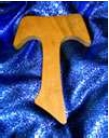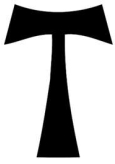The cross symbol has been a vital influence in the worship and lives of Christians. Here are seven historical forms of the cross explained and interpreted for today. Each page includes the history of the particular cross, a meaningful devotion and suggested daily reading for personal meditation. The sign of the cross series can serve as the basis for Lenten devotions, sermons, worship, or study.
Tau Cross - Repentance
"As Moses lifted up the serpent in the wilderness, so the Son of Man must be lifted up (on the cross) that whoever believes in Him may have eternal life." - Num 21:9The Sign of the Cross
The cross is the central symbol of our Christian faith. For centuries it has been a vital influence in the worship and lives of countless believers. No other emblem has had the widespread significance of the cross. Indeed, it is the supreme sign of Christianity communicating sacrifice, salvation, and hope to generations responsive to its familiar and continuing presence among us.
The cross, therefore, is a real and most appropriate symbol for penitential contemplation during Lent. In its many manifestations, it has expressed different things to diverse people throughout history. The development of the cross mark is a fascinating study and an enriching experience for our faith. It has become an inscribed letter in the alphabets of many early civilizations. As such, it has taken the form of the letters "T", "X", or the plus sign (=) in mathematics.
The cross is older than Christianity. It is , perhaps the oldest symbol in the world. The figure formed by the intersection of two lines is found pained and scratched on stones dating back to the earliest expressions of human antiquity. People who study the past believe such cruciform marks were intended as signs which would avert evil and give protection. Similar marks are indeed found widely in the whole history of ancient religions and a similar protective significance may often be surmised for them.
Tau Cross

The snake-intertwined TAU cross staff held by Moses reminds us that many of our symbols, including the evolution of alphabetical characters, were taken from literal objects, in this instance, a banner pole or staff. The name Tau is actually the term in Greek for the letter T. In Hebrew, it is called "Taw" and is the twenty-second and last letter in the Jewish alphabet using the symbol " (** Hebrew Tau here **) ." Originally the Taw was similar to a cross, but over the centuries the handwritten character changed to its present form. The word "Taw" literally means "mark" in Hebrew.
The Greek letter "Chi" (X) pronounced ki (**an i with a long vowel mark above **) which is the first letter/sound for our Lord's title, "Christ"(meaning messiah or anointed one), is also a sideways tilted cross like an X and was recognized as an equivalent of the Taw. The early Christians saw a double meaning in this initial representing Jesus and included the Greek letter, usually combined with the Greek letter "Rho" (P) as a monogram or insignia in their inscriptions. Such Christ symbols were called "Christians," a word formed by the joining shortened versions of Chris(t) plus monogram).
In the Old Testament the Taw, meaning "cross mark', was used as a signature much like an X is a legal signature today for someone who can't write his name. In Job 31:35 it says "Here is my signature!" Translated literally from the Hebrew text it reads "Here is my mark (taw)." In Ezekiel 9:4-9 there is reference to ritual marks on the foreheads of people designated as faithful to the Lord. The mark, probably a Taw or cross sign, in this instance puts its wearer under God's protection for deliverance from a fate that will strike the unmarked. The use of this sign probably originated with the first Passover when, according to tradition, the Israelites put lamb's blood on their door frames in the form of a Tau cross. Thus the angel of God destroyed the first born of the Egyptians but "passed over" the houses of the Israelites (Exodus 12).
Marked for Repentance
 Today in observance of Ash Wednesday some Christian faiths, notably the Roman Catholics, the Anglicans, and the Episcopalians still mark the foreheads of their followers with ashes in the sign of a cross. This custom at the beginning of Lent represents repentance and sorrow for sins. It reminds the faithful of the words, Remember, humanity, that you are dust, and into dust you shall return." The ashes in this ceremony are made by burning the palms from Palm Sunday the previous year.
Today in observance of Ash Wednesday some Christian faiths, notably the Roman Catholics, the Anglicans, and the Episcopalians still mark the foreheads of their followers with ashes in the sign of a cross. This custom at the beginning of Lent represents repentance and sorrow for sins. It reminds the faithful of the words, Remember, humanity, that you are dust, and into dust you shall return." The ashes in this ceremony are made by burning the palms from Palm Sunday the previous year.
In the early history of the church the ancient sacramental imposition of ashes was only used for public sinners, but about the year A.D. 1000 all the clergy and faithful started to receive the ashes as a sincere and external token that we all need God's forgiveness, Even those who do not participate in the tradition of ashes, if nonetheless still provides a powerful reminder that Lent is a time of special penance and cleansing of our hearts through prayer, contrition, and self-denial.
Jesus' death on a cross gave the ancient sign a new meaning, instead of an instrument of humiliating execution it was transformed into a symbol of life and God's love. On Calvary/ Golgotha the vertical dimension of divine concern intersected the horizontal development of human history. We glimpsed in that eternal event the lengths to which God in Christ has gone to save us. Indeed, by the sign of the cross on our forehead or in our repentant heart God has marked us as His own.
A Symbol of Healing and Hope.
In John's gospel (John 3:14) an analog is made between the serpent Moses lifted up on a standard-bearing pole in the wilderness and the raising up of Jesus on the cross, from a grave and ultimately to His exaltation and glory at the Ascension. According to tradition, the pole on which Moses elevated the bronze snake was a T shaped Tau cross similar to the looped "ANKH" symbol of life used by the Egyptians. It probably is an ancestor of the winged staff of Hermes called a "caduceus" and the snake-entwined staff of Aesculapius, both of which are used as healing emblems by the medical professions.
In Numbers (Num 21:9) the original context of the reference, the Israelites had been bitten b poisonous snakes. The bronze serpent Moses was commanded by God to erect saved those who were bitten and looked to it for health and life. Similarly, the Son of Man (Jesus) had to be lifted up on a cross in the midst of humanity poisoned by sin in order that whoever looks to Him in faith will receive the divine gift of eternal life.
The effects of the deceitful serpent in Genesis and the punishing, poisonous snakes in the wilderness are overcome by a new sign of God's salvation. The Tau cross is an occasion of repentance. It reminds us of God's universal intention to help all who turn to Him in hope and expresses the ultimate manifestation of Divine Love.
Meditation and Further Reflection
O Lord, Lent is a time of personal inventory and an opportunity to turn away from our everyday concerns toward the truth offered through the cross. As we reflect on the Tau cross perhaps it is appropriate that we pause and imagine a crucifix, for without the sight of Christ lifted up and suffering, we might forget the reality of the crucifixion.
May it continue to have the power to bring us to faith and repentance, just as the contemplation of the bronze serpent lifted up by Moses was able to heal the Israelites bitten by the fiery serpents. In the season of Lent ahead, O Lord, inspire us to make time for devotion and to search for a new quality of existence available now, that our faith might be more meaningfully applied in our relationships with You and others, for we ask it in Your name. Amen.
Readings
- Ash Wednesday - Matthew 4:1-7
- Thursday - Genesis 3:1-24
- Friday - Exodus 4:1-5, 7:1-24
- Saturday - Numbers 21:1-9, John 3:1-21
Hear the Message
© 2024, Dr. Neal Carlson. All Rights Reserved.
 Tau – Repentance
Tau – Repentance Maltese – Protection
Maltese – Protection Jerusalem – Healing
Jerusalem – Healing Anchor – Hope
Anchor – Hope Celtic – Mission
Celtic – Mission Latin – Suffering
Latin – Suffering Cross & Orb – Victory
Cross & Orb – Victory